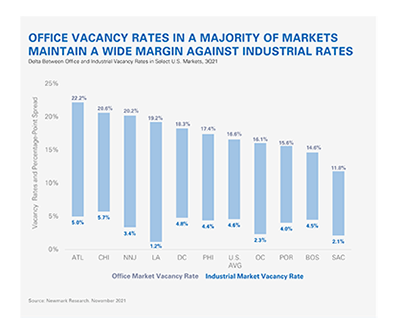
Office-to-Industrial Conversions Increase

As the industrial market soars and the office market remains soft, more developers are converting office product into industrial properties, reported Newmark, New York.
In Divergent Market Fundamentals Drive Office-to-Industrial Conversions, Newmark noted “unprecedented” industrial demand across the U.S. has left tenants with a critical shortage of space options, reflected in a record low 4.6 percent industrial vacancy rate in the third quarter.
“Comparatively, the U.S. office market is contending with uncertainty in the post-COVID-19 world, and the pandemic has only accelerated obsolescence of some older, less-amenitized product,” the report said. “This divergence among asset classes is increasingly driving investors and developers to consider industrial redevelopment opportunities for some unproductive office properties.”
Since 2018, at least 45 office properties totaling 11.3 million square feet either have been redeveloped or are in the process of redevelopment into industrial use, Newmark reported. “This observed activity is predominantly concentrated in markets where density and land constraints are driving forces, resulting in perennially tight industrial vacancy,” the report said. “While office space generally costs significantly more to build than industrial and yields higher rents when occupied, the economics supporting industrial redevelopment in these regions are buoyed by exceptionally strong market fundamentals.” It said office vacancies are roughly 10 to 18 percentage points higher than industrial vacancies as of the third quarter.
But office-to-industrial redevelopment can be complicated, Newmark said. The most likely candidates for office-to- industrial conversions are older suburban office assets occupying 15 to 25 acres within a few miles of a major highway.
“Layering in zoning considerations, existing land availability, industrial and office submarket fundamentals and other geographic attributes will also inform strategy, as not all obsolete office buildings present opportunity,” the report said. Sites may face challenges including community opposition and zoning restrictions that increase development costs as well as challenges from competing uses including multifamily, healthcare and life sciences reuse.
“The office-to-industrial conversion trend, while niche, will continue to grow and will offer industrial tenants much-needed space while tightening existing office inventories by removing properties that are no longer competitive,” Newmark said.
